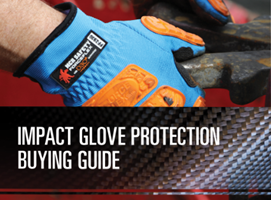30 Apr 04/30/2019
Oil Rig Safety Gear: PPE Worn Across On-Shore Drilling and Production Operations

MCR Safety gloves, glasses, and garments worn on a drilling rig
Rigging Up

Substructure
Rigging up is the placement and assembly of the rig itself, and preparing it for drilling. This phase involves the use of cranes, trucks, forklifts, and other heavy machinery to position equipment for assembly, offering plenty of opportunities for workers to be hit by moving vehicles or swinging equipment. Assembling the rig can mean pinched fingers or the occasional falling tool. With so much in motion, high-visibility clothing and impact protection gloves can help keep the rigging up process on track.
Here are the seven steps OSHA’s eTool identifies as being a part of rigging up. Next to each link, we list the potential hazards MCR Safety can assist in protecting against. Just click the link to start viewing the PPE options available to you.
| Activity | Hazard |
| Substructure setup |
|
| Rig floor setup | |
| Handrail installation | |
| Power system installation | |
| Circulating system rigging | |
| Auxiliary equipment installation | |
| Rig inspection | |
| Rigging down | Hazards are similar to those listed above, just in reverse order |
Drilling Ahead

Drill Rig Illustration

Working around chains
Once the rig is built, it’s time for drilling ahead. In addition to the constant risk of being struck by tongs, spinning chain, or pipe, drilling workers also face the possibility of flash fire. 16% of all oil and gas fatalities are the result of exposure to flash fires. Although they last just seconds, flash fires can cause devastating burns to an unprotected worker. Flame-resistant garments can greatly reduce injury because they do not continue to burn after a flash fire has gone out.
Here are the ten tasks OSHA’s eTool identifies as part of the drilling process. Next to each link, we list the potential hazards MCR Safety can assist in protecting against. Just click the link to start viewing the PPE options available to you.
| Activity | Hazard |
|---|---|
| Tubular/pipe handling | |
| Drilling fluid preparation | |
| Drilling begins | |
| Preparing to break out pipe | |
| Breaking out pipe |
|
| Making up pipe | |
| Raising the Kelly | |
| Adding pipe | |
| Drilling resumes | |
| Coring |
Tripping Out and In
Eventually, the bit or some other piece of the drill string is going to need to be replaced. Removing or replacing pipe from the well is known as tripping, runs the risk of exposing workers to excess drilling mud. This fluid may contain chemicals that can cause burns when it comes in contact with skin or eyes. PVC gloves and safety glasses can help prevent this type of injury.
OSHA’s eTool identifies eight activities completed during the tripping out/in process. Next to each link, we list the potential hazard MCR Safety can assist in protecting against. Just click the link to start viewing the PPE options available to you.

Drilling mud

Oil and gas pipes
| Activity | Hazard |
|---|---|
| Setting slips | |
| Setting back the kelly |
|
| Elevator attachment | |
| Latching elevators | |
| Monkeyboard work | |
| Breaking out pipe | |
| Pipe to racking area |
|
| Tripping in |
Casing Operation

Multiple casings cemented together
Casing is used to line the well hole with pipe longer and bigger in diameter than the drill pipe. Casing operations happen periodically during drilling, with hazards similar to that of drilling or tripping. Gloves with impact protection help safeguard hands and are a key piece of PPE when running casing.
Here are four operational activities OSHA’s eTool identifies while casing. Next to each link, we list the potential hazard MCR Safety can assist in protecting against. Just click the link to start viewing the PPE options available to you.
| Activity | Hazard |
|---|---|
| Casing tools installation | |
| Running casing | |
| Casing accessories installed |
|
| Circulating and cementing |
Maintenance Activities

Rig Floor

Oil and Gas Derrick
Maintenance is a constant activity on any drilling rig. Inspecting, adjusting, and servicing equipment on every part of the rig brings maintenance workers into contact with all kinds of possible hazards. The right PPE can prevent chemical exposure while cleaning out the mud circulating system or cuts from wickers or loose strands during wire rope maintenance.
Here are the seven activities OSHA’s eTool identifies as taking place during maintenance. Next to each link, we list the potential hazard MCR Safety can assist in protecting against. Just click the link to start viewing the PPE options available to you.
| Activity | Hazard |
|---|---|
| Rig floor | |
| Line maintenance | |
| Rope maintenance | |
| Mud circulating |
|
| Electrical | |
| Engines |
|
| Derrick maintenance |
Well Control

Mud Flow

Hoses are used all across drilling operations
Keeping the right pressure in the rig to prevent blowouts is the vital job of well control workers. Monitoring and maintaining the mud circulatory system is an important part of this function, as is testing blowout preventers, accumulators, and the choke manifold.
Well control also includes maintaining the surface control system. Physically checking these components requires workers to navigate a veritable maze of pipes and protruding objects. Steel-toed PVC boots can help prevent foot impact injuries while also offering protection from chemical spills or hydraulic leaks.
Here are the five activities OSHA’s eTool identifies as being a part of well control. Next to each link, we list the potential hazard MCR Safety can assist in protecting against. Just click the link to start viewing the PPE options available to you.
| Activity | Hazards |
|---|---|
| Blowout prevention |
|
| Monitoring and maintaining | |
| Installation | |
| Bops, accumulators, and choke manifold | |
| Surface control |
Impact Protection
Drilling PPE


Eyewear Buying Guide
Each year, more than 2.5 million eye injuries occur. Protect yourself by finding the right eye protection for the job.

MCR Safety Impact Glove Protection Buying Guide
About the Author
Related Articles

Everything You Need to Know About The New ANSI ISEA 138 Impact Protection Standard
While there is a hand-protection standard in North America, ANSI/ISEA 105: 2016, American...
The Top Workplace Hazards for Oil and Gas Workers
If you work in the oil and gas industry, you know that the hazards you and your fellow workers...
Top 10 Most Popular Oil and Gas Gloves, Glasses, and Garments
We work hard, so that you can tool. Learn about our top 10 Most Popular Oil and Gas Gloves...
Highlighting Heavy Duty Impact Cotton Gloves
Cotton gloves have been popular for a long time, and for good reason. They are well-suited for...
Oil Rig Safety Gear: PPE Worn Across On-Shore Drilling and Production Operations
Drilling for oil and natural gas has always been a dangerous occupation. From the first day of...Latest Articles








